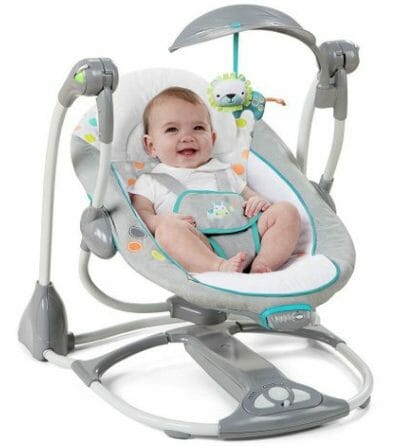Container Baby Syndrome / Container Baby Shuffle happens easily, it is part of our day to day reality, and part of our busy structured lifestyles. I also feel that the way we live, often without extended family or without lots of friends in the same position, has contributed to the need for parents to have somewhere safe to put their babies while they grab a few minutes for the necessary activities of daily life.
What constitutes a container?
Major factors contributing to Container Baby Syndrome
In 1992, new guidelines were introduced by health care workers to help prevent Sudden Infant Death Syndrome (SIDS). SIDS was thought to be caused by infants sleeping on their stomachs with soft material around them that could block their breathing leading to death. So a campaign was developed called ‘Back to Sleep’, this included placing babies on their backs and removing cot obstacles. Since this program, there has been a fifty percent decrease in SIDS, and I always say to parents “I’m old enough to have friends whose babies died from SIDS and the result of this program is wonderful”. The downside is that tummy time has reduced significantly, and the time babies spend in containers has dramatically increased.
Many parents may extend the ‘back to sleep’ position to day to day ‘awake time’ to keep their baby safe. For others, it is containers for baby-sitting and where the baby seems restful and content. I always mention, “well yes, I like being in my rocking chair but if I did it all day, I would get weak and find going to the gym and exercising hard work and tiring, and it’s the same for babies”.
Because of the container positioning, baby spends less time on his tummy, holding up his own head, sitting on his own or using his hands for balance, rolling etc.
Once they are taken out of the containers and put on their tummy to play, babies express their discontent with ‘gym’ time by crying. This can cause parents to be concerned and they put their baby back in the container and thus begins the container baby shuffle!! Even if a baby is unsettled, this tummy time is a baby’s work time where they are learning movement skills integral to development. Tummy time provides the opportunity to gain head control, experience weight bearing through their arms and develop trunk extension against gravity. Also very importantly it promotes and maintains a rounded head shape and allows the experience of movement, motor planning and co-ordination.
Container Baby Shuffle may contribute to:
- Change in shape of the skull(plagiocephaly)
- Facial asymmetry(due to changed skull shape or brachycephaly)
- Torticollis(tight neck muscles)
- delayed development of gross motor skills
- tummy time
- rolling
- crawling
- delayed standing
- walking
- poor weight bearing through the hands in sitting/tummy
- anxiety on moving within and out of positions(as has been held still in one position)
- decreased strength
- poor risk taking, fear of falling etc.
What can you do?
Tips for home
- Positioning – put your baby in a variety of positions but avoid the container shuffle.Floor time is not only necessary but should be fun. So let your baby have time on their backs, sides and tummy. Recent research says babies should be on their tummies at least three times a day. I say as much as possible! – up to 2 hours per day. Tummy time also includes carrying, holding on your lap and placing on the floor to play.
- Carry your baby – use a sling if your baby is unsettled, you’re going for a walk or you need hands free for a toddler. Slings allow your baby to socialise and experience movement both theirs and yours. Carry your baby on your hip, in your arms on their tummy, in your arms on their sides, in a sitting position over your shoulder.
- Limit Container time – Car seats are for the car, pick up your baby and carry him, then place him on the floor, on your lap etc. Try using the pram in a different way – if it’s flat put your baby on his tummy while awake – face pram to you. Have mobiles on the pram so baby can hit/kick at them to encourage movement. If your baby continues to struggle with time out of the container, has a flat head, no tolerance to tummy time or other movement issues, then a paediatric physio can help.
What happens at physiotherapy?
When you attend a paediatric physio for your baby, the physio will ask about your baby’s birth history, movement, positions they play in and about your particular concerns. She will then look at your baby’s movement, head shape, vision (tracking you / toys with thier eyes), tolerance to positioning and changes of movement.
If your baby has a flat head or difficulty turning their head to one side, research states that the earlier the intervention is begun the better. A Paediatric Physiotherapist will treat your baby and give you advice for home.
Treatment includes
Therapist intervention
Parent Education
In Conclusion
Container baby shuffle is a part of daily life but the effects can be reduced by trying the tips suggested in this blog. It will always be necessary to use a car seat, pram, cot, high chair etc. but use these for their specific purpose and balance this use with free time on the floor or in your arms as much as possible.
Enjoy your baby and their developing movement skills!




